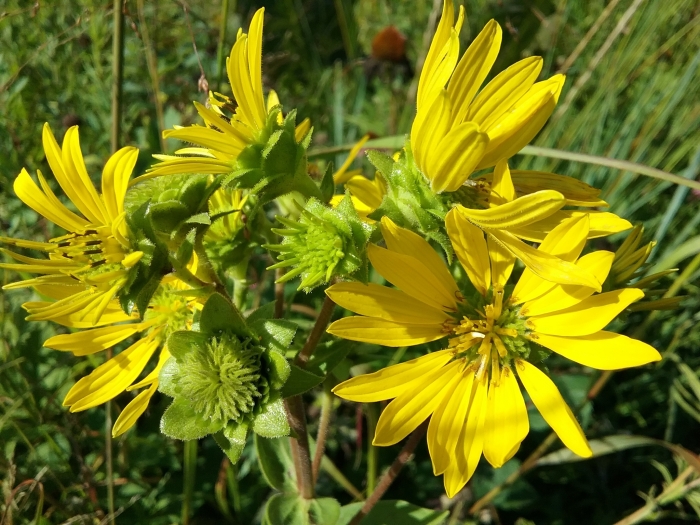Wholeleaf Rosinweed
(Silphium integrifolium)
Wholeleaf Rosinweed (Silphium integrifolium)
/
/

Mary Crickmore
Public Domain
Image By:
Mary Crickmore
Recorded By:
Copyright:
Public Domain
Copyright Notice:
Photo by: Mary Crickmore | License Type: Public Domain | License URL: http://creativecommons.org/publicdomain/zero/1.0/ | Rights Holder: Mary Crickmore | Publisher: iNaturalist | Date Created: 2019-08-27T09:17:09-07:00 |

















































Estimated Native Range
Summary
Silphium integrifolium, commonly known as Wholeleaf Rosinweed, is a perennial herb that is typically evergreen in warmer climates and semi-deciduous in colder regions. It is native to the tallgrass prairies and glades of the Central and Eastern United States. This plant can reach a height of 3 to 6 feet (0.9 to 1.8 meters) and a width of 2 to 4 feet (0.6 to 1.2 meters). The inflorescence consists of one to 15 bright yellow flower heads that resemble sunflowers, blooming from mid-summer to early fall. The flowers are highly attractive to pollinators, including bees, butterflies, and moths, making it an excellent choice for pollinator gardens.
Wholeleaf Rosinweed is valued for its drought tolerance and ability to thrive in poor soils, making it a low-maintenance option for gardeners. It is often used in prairie restorations, naturalized areas, and as a border plant in gardens. It prefers full sun but can tolerate light shade and requires medium amounts of water with well-drained soil. While it is shorter and less prone to toppling than other Silphium species, it is also appreciated for its slower spread, reducing the need for frequent division or control. It is not known to be allelopathic, which means it does not inhibit the growth of surrounding plants through chemical means, unlike some sunflowers.CC BY-SA 4.0
Wholeleaf Rosinweed is valued for its drought tolerance and ability to thrive in poor soils, making it a low-maintenance option for gardeners. It is often used in prairie restorations, naturalized areas, and as a border plant in gardens. It prefers full sun but can tolerate light shade and requires medium amounts of water with well-drained soil. While it is shorter and less prone to toppling than other Silphium species, it is also appreciated for its slower spread, reducing the need for frequent division or control. It is not known to be allelopathic, which means it does not inhibit the growth of surrounding plants through chemical means, unlike some sunflowers.CC BY-SA 4.0
Plant Description
- Plant Type: Herb
- Height: 2-6 feet
- Width: 1-3 feet
- Growth Rate: Rapid
- Flower Color: Yellow
- Flowering Season: Summer, Fall
- Leaf Retention: Deciduous
Growth Requirements
- Sun: Full Sun
- Water: Medium
- Drainage: Slow, Medium, Fast
Common Uses
Bee Garden, Bird Garden, Border Plant, Butterfly Garden, Drought Tolerant, Fragrant, Low Maintenance, Showy Flowers, Street Planting
Natural Habitat
Native to tallgrass prairies and glades in the Central and Eastern United States
Other Names
Common Names: Whole-Leaved Rosinweed, Whole-Leaf Rosinweed, Rosinweed, Entire-Leaf Rosinweed, Prarie Rosinweed, Silflower, Ungeschlitzte Becherpflanze, Silphe À Feuilles Entières, Solört
Scientific Names: , Silphium integrifolium, Silphium integrifolium var. deamii, Silphium integrifolium var. neglectum, Silphium integrifolium var. ternatum, Silphium laevigatum,
GBIF Accepted Name: Silphium integrifolium Michx.